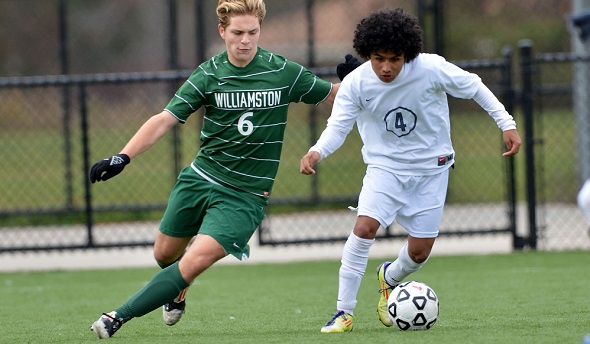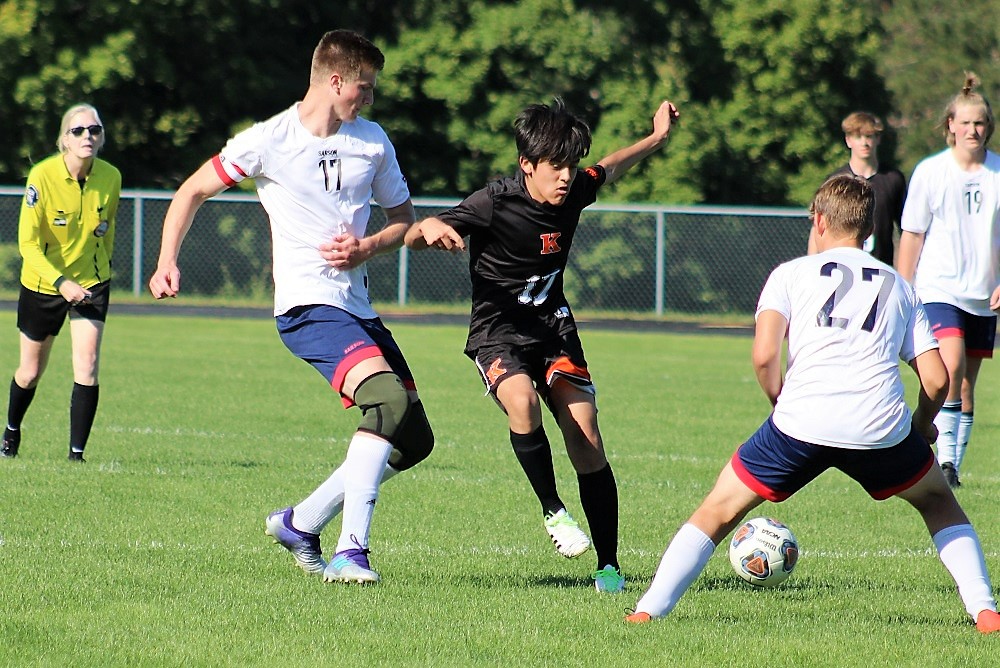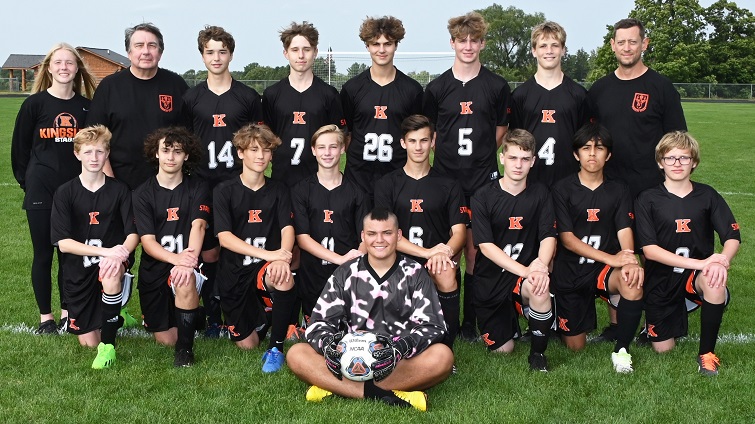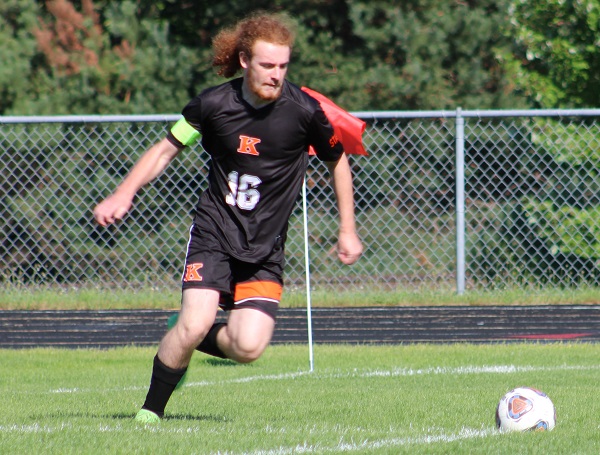
Preview: Contenders Aiming to be Champions
November 1, 2013
By Geoff Kimmerly
Second Half editor
Five teams will look to make history Saturday as they play for their first MHSAA boys soccer championships. And at least two are assured of doing so.
The Lower Peninsula Division 1 and 4 championship games feature four teams looking to win for the first time, including first-year school Bloomfield Hills. Spring Lake in Division 2 also is going for its first Finals win, but against three-time champion East Lansing and one of the state’s winningest coaches in Nick Archer.
Only in Division 3 is a team assured of adding to its trophy collection. Flint Powers Catholic is hoping for its first title since 1996, but must beat reigning champion Grand Rapids South Christian to earn it.
Below is Saturday's schedule, followed by a look at each team in the hunt.
Division 1 at Troy Athens, Noon
Bloomfield Hills (16-2-5) vs. Ann Arbor Skyline (20-1-5)
Division 2 at East Kentwood Crestwood Middle School, Noon
East Lansing (24-2) vs. Spring Lake (16-6-3)
Division 3 at Troy Athens, 3 p.m.
Grand Rapids South Christian (21-1-3) vs. Flint Powers Catholic (14-8-2)
Division 4 at East Kentwood Crestwood Middle School, 3 p.m.
Grand Rapids Covenant Christian (22-1-3) vs. Lansing Christian (21-0-1)
All four Finals will be streamed live on MHSAA.TV and available on a subscription basis. A one-day pass costs $9.95 and allows access to all four games plus the Lower Peninsula Cross Country Finals. A month pass costs $14.95 and allows fans to also watch live the Volleyball Semifinals and Finals and Lower Peninsula Girls Swimming & Diving Finals. Radio broadcasts of the Soccer Finals will be available on MHSAAnetwork.com.
Click for links to brackets and scores. All statistics below are through the Regional Finals.
DIVISION 1
ANN ARBOR SKYLINE
Record/rank: 20-1-5, No. 3
Coach: Chris Morgan, fourth season (53-17-16)
League finish: Second in Southeastern Conference Red
Championship history: Has never played in an MHSAA Final.
Players to watch: Alec Lasinski, jr. F (32 goals, six assists); Nick Russo, sr. M (11 assists, three goals).
Outlook: Skyline has improved in the win column each season during its four as a varsity program and won its second straight District title two weeks ago. The Eagles beat No. 5 Caledonia and honorable mentions Okemos and Salem to win the Regional and advance to the championship game. Lasinski earned an all-state honorable mention as a sophomore and leads an offense that has outscored opponents 74-15 with 14 shutouts this fall.
BLOOMFIELD HILLS
Record/rank: 16-2-5, unranked
Coach: Dougie Macaulay, first season (16-2-5)
League finish: Second in Oakland Activities Association White
Championship history: First season as a school.
Players to watch: Alex Joneson, jr. F; Griffin Hamel, sr. GK (statistics not submitted).
Outlook: This is the first year of Bloomfield Hills soccer and school, which was created by a merger of Lahser and Andover. Lahser won one MHSAA title and finished runner-up twice during its history. The only teams to score more than one goal on Bloomfield Hills this season were the two that beat the Black Hawks, Rochester Hills Stoney Creek and Birmingham Groves. Bloomfield Hills has won 13 straight, including avenging that loss to Groves with a 4-1 win in the District opener.
DIVISION 2
EAST LANSING
Record/rank: 24-2, No. 4
Coach: Nick Archer, 38th season (572-152-72)
League finish: Second in Capital Area Activities Conference Blue
Championship history: Three MHSAA titles (most recent 2005), two runner-up finishes.
Players to watch: DeJuan Jones, jr. F (25 goals, eight assists); Tommy Lammers, sr. M (six goals, five assists); Ben Swanson-Ralph, sr. F (14 goals, 12 assists).
Outlook: East Lansing advanced with its first Regional title since 2007, but was poised for such a run after claiming the league and District titles in 2012 with Swanson-Ralph making the all-state first team and Lammers earning an honorable mention. The Trojans spent much of this season ranked No. 1 before a couple close losses near the end to No. 6 DeWitt and Division 1 honorable mention Okemos. East Lansing then beat DeWitt and No. 2 Linden on its way to this championship game.
SPRING LAKE
Record/rank: 16-6-3, unranked
Coach: Jeremy Thelen, 13th season (200-70-11)
League finish: Second in Lakes 8 Conference
Championship history: 2011 runner-up.
Players to watch: Nic Ellingboe, sr. F (19 goals, seven assists); Kyle Zietlow, jr. M (10 goals, 12 assists); Keegan George, soph. F (13 goals, six assists).
Outlook: This is Spring Lake’s second Division 2 Final appearance in three seasons, and the Lakers are riding a seven-game winning streak including a shootout victory over Fruitport after losing to the Trojans in the league championship game. In fact, Spring Lake could make a run at three Finals berths in four seasons next fall; Ellingboe and defender Adam Ross are the only senior starters.
DIVISION 3
FLINT POWERS CATHOLIC
Record/rank: 14-8-2, No. 6
Coach: Tony Rowe, second season (28-15-2)
League finish: First in Saginaw Valley Association
Championship history: Class B champion 1996.
Players to watch: Jared Pechette, sr. M (10 assists, eight goals); Christian Mansour, sr. M (15 assists, five goals); Charlie Emmert, sr. F (13 goals, three assists).
Outlook: Powers has piled up successes with two league titles under Rowe, a 2003 graduate in his first varsity coaching position. The Chargers are riding a 12-game unbeaten streak after beginning the season 3-6. Although Powers has only six seniors, three start in the midfield with Brad Tuttle joining Pechette and Mansour.
GRAND RAPIDS SOUTH CHRISTIAN
Record/rank: 21-1-3, No. 1
Coach: Jason Boersma, third season (58-8-8)
League finish: First in O-K Gold
Championship history: Two titles (most recent 2012), one runner-up finish.
Players to watch: Marlon Bykerk, sr. M (11 goals, 17 assists); Cody Kok, sr. M (11 assists, nine goals); Nick VanderHorst, sr. M (13 goals, three assists), Zac Medendorp, sr. GK (0.45 goals-against average, 15 shutouts).
Outlook: South Christian is playing for its third title in four seasons led by a talented midfield including 2012 all-stater Bykerk and honorable mention Kok and a keeper whose shutout total makes the MHSAA record book (Medendorp earned his 16th in the Semifinal against No. 5 Whitehall). The Sailors’ lone loss this season was in their opener, 1-0 to Division 2 honorable mention Grand Rapids Christian – and South Christian won the rematch 2-1.
DIVISION 4
GRAND RAPIDS COVENANT CHRISTIAN
Record/rank: 22-1-3, No. 1
Coach: Mike Noorman, 10th season (127-66-14)
League finish: First in River Valley Conference
Championship history: 2012 runner-up.
Players to watch: Corbin Prince, sr. M (27 goals, 15 assists), Travis Bouwkamp, jr. F (23 goals 16 assists), Cole Bleyenberg, sr. F (12 goals, nine assists), Austin Brower, sr. GK (0.28 GAA, 13 shutouts).
Outlook: After falling short to Hamtramck Frontier International in last season’s Division 4 Final, Covenant Christian has dominated in its quest to finish the run this fall. Brower was an all-stater as a junior and Prince made the second team. They are two of 11 seniors on a team that started with seven straight shutouts and has given up only three goals during the postseason despite dispatching of No. 2 Kalamazoo Hackett Catholic Central and No. 10 Bellaire during the run.
LANSING CHRISTIAN
Record/rank: 21-0-1, honorable mention
Coach: Joel Vande Kopple, sixth season (114-15-5)
League finish: Does not play in a league.
Championship history: Has never played in an MHSAA Final.
Players to watch: Jordan Terry, sr. F (26 goals, 11 assists), Martin Lang, Jr., jr. F (18 goals, eight assists), Brayan Guzman-Ortiz, jr. F (11 goals, six assists), Alex McDowell, soph. M (11 goals, five assists).
Outlook: The Pilgrims didn’t enter the tournament among the top 10. But Lansing Christian proved its skill early with wins over Division 2 Haslett and Division 3 Williamston, and then beat Division 4 honorable mention Genesee Christian and No. 7 Bloomfield Hills Roeper on the way to this first Final. Terry is a returning all-stater and a dangerous scorer, but the defense is talented as well – the Pilgrims didn’t give up a goal in the playoffs until Roeper scored one in the Semifinal.
PHOTO: Grand Rapids South Christian’s Marlon Bykerk (4) advances the ball during last season’s Lower Peninsula Division 3 Final win over Williamston. He and his team return to the championship game Saturday. (Click to see more from High School Sports Scene.)

Records May Not Show It - Yet - But Kingsley Soccer Improving, Ready to Rise
By
Tom Spencer
Special for MHSAA.com
October 21, 2022
Kingsley did not go on unnoticed this fall in Northwest Conference soccer play.
 In fact, many took considerable notice of the Stags.
In fact, many took considerable notice of the Stags.
And, the coaches of the league’s top teams are looking for even bigger things ahead from Kingsley. Quite, frankly, they’re hoping it comes to fruition for their own teams’ sakes.
“It’s always beneficial to have a solid conference – as it helps teams prepare for playoffs,” said Rob Sirrine, coach of this year’s league title winner, Leland. “We expect them to improve in the next few years.
“Kingsley has had a rough go of it the last few years – not unlike other schools in our conference that also have football teams,” he continued. “I think they have some potential based on the coaches they have brought in and volunteers that are helping out the program.”
Second-year Kingsley head coach Tim VanWingerden welcomed Mike Alanson as a volunteer varsity assistant coach and two middle school coaches — Bert Baker and Lars Mitchell — this fall. Baker and Mitchell had kids on the Stags’ middle school squad this season.
League opponents, including the varsity coaches, noted big differences already.
Buckley coach John Vermilya, whose Bears finished second this year after winning the crown a year ago, echoed Sirrine.
“Kingsley has shown incredible resilience over the last three seasons,” Vermilya said. “This season they bounced back with an influx of young players, and you can see their growing tactical awareness along with technical ability.”
Youth soccer is growing in the Kingsley community as well, adding to the excitement. In fact, VanWindergen has two boys —Ted, 10, and Gunnar, 9, playing in the youth program. Tabatha VanWingerden, wife of the Stags’ head coach, is the coach of the U-12 team.
 Mitch Miggenburg, Kingsley’s athletic director, is pleased to see the growth in numbers as the Stags move through “a 3-5 year” plan to become more competitive in soccer and cross country. He’s hoping those sports can find success similar to that of the Stags’ football team.
Mitch Miggenburg, Kingsley’s athletic director, is pleased to see the growth in numbers as the Stags move through “a 3-5 year” plan to become more competitive in soccer and cross country. He’s hoping those sports can find success similar to that of the Stags’ football team.
Kingsley is 6-2 on the gridiron and looking ahead to the football playoffs again. The Stags are fielding a full squad of cross country runners this fall after some lean years.
With an enrollment of well under 500, Kingsley has been able to involve 62 boys in football, 10 in cross country and 17 in soccer. Miggenburg noted cuts had to be made to the school’s co-ed middle school team this fall.
“I think we’re headed in the right direction,” Miggenburg said. “If you look at our record, you might not see it.
“This is not something that is going to happen overnight,” he continued. “In order for us to develop the way we want to develop, we’ve got to put some time in outside the season. And we have some coaches willing to help and do that, and it will only benefit us in the future.”
The Stags have not won a game the last two seasons, but VanWingerden believes success, as defined by wins, is right around the corner. He knows his team has shown moments of brilliance in every contest before the goals mounted against the Stags.
VanWingerden and Kingsley have been praised for outstanding sportsmanship by referees, opposing players and coaches.
Other bright spots in 2022 included outstanding play by freshman goalie Nate Lamie and stellar defense by senior captain Zakkeus Bedford. The Stags will have to overcome the loss of Bedford, their only senior this year, who played with tremendous drive and was the leader on the field.
But, they should return rest of the squad hungry for wins. And, they’ll add some solid incoming freshman players.
 “I think next year is going to be a big turnaround,” VanWingerden predicted. “So the next two, three years, we’re going to start turning some heads.”
“I think next year is going to be a big turnaround,” VanWingerden predicted. “So the next two, three years, we’re going to start turning some heads.”
Despite not experiencing wins either of the last two seasons, the Stags have enjoyed playing soccer.
“There is a camaraderie there with these kids I just can’t quite put my finger on, but it’s part of what binds them better, facing that adversity on a regular basis and getting though it together as a team,” VanWingerden said. “They’ve come to practice the next day determined to work hard and try to improve little by little.
“The common goal to get better pulls them together and gives them a determination that is hard to find.”
Many conference games this year were played 9 vs. 9 or 10 vs. 10 per conference agreement. Benzie Central and Glen Lake played with fewer than 11 players in every contest this season. Benzie Central, Glen Lake, Kingsley and Suttons Bay all compete in cross country, football and soccer. Leland and Buckley do not field football squads.
The Comets won a District championship 1-0 on Thursday at Suttons Bay. The Bears are playing in a District Final on Saturday in Lakeview. Kingsley’s 0-19 season ended with a Division 3 District-opening loss to Boyne City last week.
The Stags have already begun working on next year. Offseason plans include drop-in soccer and participation in a newly-developed strength and conditioning program.
“The program is not going to move forward unless we put in a ton of work,” VanWingerden acknowledged. “We’ve had glimpses into what we could be if we did it on a regular basis.
“It is really encouraging.”
 Tom Spencer is a longtime MHSAA-registered basketball and soccer official, and former softball and baseball official, and he also has coached in the northern Lower Peninsula area. He previously has written for the Saginaw News, Bay County Sports Page and Midland Daily News. He can be reached at [email protected] with story ideas for Manistee, Wexford, Missaukee, Roscommon, Ogemaw, Iosco, Alcona, Oscoda, Crawford, Kalkaska, Grand Traverse, Benzie, Leelanau, Antrim, Otsego, Montmorency, Alpena, Presque Isle, Cheboygan, Charlevoix and Emmet counties.
Tom Spencer is a longtime MHSAA-registered basketball and soccer official, and former softball and baseball official, and he also has coached in the northern Lower Peninsula area. He previously has written for the Saginaw News, Bay County Sports Page and Midland Daily News. He can be reached at [email protected] with story ideas for Manistee, Wexford, Missaukee, Roscommon, Ogemaw, Iosco, Alcona, Oscoda, Crawford, Kalkaska, Grand Traverse, Benzie, Leelanau, Antrim, Otsego, Montmorency, Alpena, Presque Isle, Cheboygan, Charlevoix and Emmet counties.
PHOTOS (Top) Kingsley’s Rolando Torres works to gain possession against Traverse City Bulldogs’ Tyler Ritola (17), Jonathon Scott (27) and Syrus Ritola (19), as Josephine Arrowood officiates. (Middle) This fall’s Kingsley soccer team. (Below) Zakkeus Bedford lines up a kick this season. (Photos courtesy of the Kingsley athletic department.)

